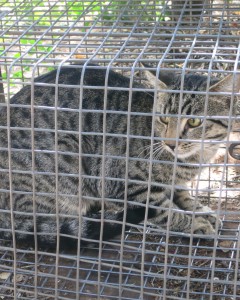Feral cats have contributed to the disappearance of many ground dwelling birds and mammals in the arid zone and continue to threaten the success of recovery programs for endangered species. As a result, they are listed as a key threatening process under the Commonwealth EPBC Act 1999.
Trapping for cats may be more successful in the cooler months due to the reduced food supply in the landscape (i.e. reptiles) during this time. Now that the air is developing more of a chill, it’s a great time to start thinking about trapping feral cats on your property.
Here are some tips for trapping feral cats:
- Trap on your own property. If trapping elsewhere you must obtain written permission from the property owner.
- Use fresh bait (chicken, raw meat or liver, smelly tinned fish).
- Set traps in the evening and check early morning to avoid accidental by-catch of native wildlife during the day.
- A cage trap placed in amongst vegetation (so that the opening is the only point available to be investigated) is likely to be more effective than placing it in open areas.
- A trap may be fitted with shade cloth to prevent captured animals from stress during the warm months and to create curiosity for cats to enter at the entrance.
- It is also thought that cats are less likely to walk on the cage floor, due to the texture of the mesh, so try covering with soil, sand, or vegetation.
Traps are available from the Alice Springs Town Council (Ph 08 8950 0500). Any captured cats can be taken to the Alice Springs Animal Shelter (Ph 08 8953 4430).
Feral cat caught in Connellan last week (J. Kreusser)
